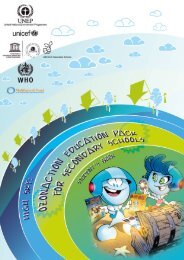Chapter 2. Progress towards the EFA goals - Unesco
Chapter 2. Progress towards the EFA goals - Unesco
Chapter 2. Progress towards the EFA goals - Unesco
You also want an ePaper? Increase the reach of your titles
YUMPU automatically turns print PDFs into web optimized ePapers that Google loves.
0<br />
1<br />
2<br />
0<br />
CHAPTER 2<br />
Education for All Global Monitoring Report<br />
Large-scale<br />
programmes<br />
in Brazil, India<br />
and <strong>the</strong> Islamic<br />
Republic of Iran<br />
are delivering<br />
positive results<br />
governments recognizing that ‘literacy is crucial<br />
to <strong>the</strong> acquisition, by every child, youth and adult,<br />
of essential life skills that enable <strong>the</strong>m to address<br />
<strong>the</strong> challenges <strong>the</strong>y can face in life, and represents<br />
an essential step in basic education’ (United<br />
Nations, 2002, p. 2). While development decades<br />
come and go, usually without meaningful impact,<br />
<strong>the</strong> literacy decade has given rise to intensive<br />
regional discussions and raised <strong>the</strong> profile of <strong>the</strong><br />
illiteracy problem (Robinson, 2009; UNESCO,<br />
2008b). The International Conference on Adult<br />
Education scheduled for late 2009 (CONFINTEA VI)<br />
provides an opportunity to move from international<br />
dialogue to international action.<br />
Literacy continues to receive insufficient attention<br />
at many levels. It is not treated as a political<br />
priority, it receives insufficient financial<br />
commitment and efforts to incorporate strategies<br />
for literacy into wider poverty reduction plans<br />
remain underdeveloped (Caillods and Hallak, 2004;<br />
Giffard-Lindsay, 2008; Lindt, 2008). Even so, some<br />
governments have demonstrated through practical<br />
action that national programmes deliver results.<br />
O<strong>the</strong>rs have increased financing commitments<br />
for literacy. And a vast array of partnerships and<br />
approaches are now promoting literacy at <strong>the</strong><br />
community level (Oxenham, 2008).<br />
Some governments have openly acknowledged<br />
that neglect of literacy was a serious policy failure<br />
(Lindt, 2008). One of <strong>the</strong> most far-reaching efforts<br />
to correct that failure is <strong>the</strong> Literate Brazil<br />
Programme (Box <strong>2.</strong>21). In <strong>the</strong> Islamic Republic<br />
of Iran, community learning centres initiated by<br />
<strong>the</strong> Literacy Movement Organization, a government<br />
agency, have enrolled 3.1 million illiterates from<br />
2000 to 2006 in preliminary basic education<br />
courses. Around three-quarters of those enrolled<br />
successfully complete <strong>the</strong>ir courses (Richmond<br />
et al., 2008). In Burkina Faso, <strong>the</strong> government has<br />
adopted <strong>the</strong> bold target of increasing adult literacy<br />
rates from 28% to 40% by 2010. That target has<br />
been backed by an increase in <strong>the</strong> share of <strong>the</strong><br />
education budget allocated to literacy from 1% to<br />
7% – a move that has facilitated <strong>the</strong> expansion of<br />
permanent literacy training centres and centres<br />
for non-formal basic education. Graduation from<br />
<strong>the</strong>se centres grew by 24% from 2003 to 2007<br />
(Richmond et al., 2008).<br />
Ano<strong>the</strong>r example comes from India, where <strong>the</strong><br />
National Literacy Mission, launched in 1988, has<br />
been revitalized. The eleventh five-year plan, which<br />
ends in 2012, has quintupled <strong>the</strong> mission’s budget<br />
to <strong>the</strong> equivalent of US$21 billion. Programmes<br />
have been redesigned to provide an integrated<br />
approach that combines initial literacy training<br />
with ongoing post-literacy courses.<br />
Decentralization is transferring authority to states<br />
and districts, and a much stronger commitment<br />
has been made to preparing literacy materials in<br />
local languages. In 2009, <strong>the</strong> Government of India<br />
also signaled a stronger focus on gender and<br />
equity, first by recasting <strong>the</strong> National Literacy<br />
Mission as <strong>the</strong> National Female Literacy Mission<br />
and <strong>the</strong>n by announcing a strategy for targeting.<br />
Commitments have been made to ensure that<br />
85% of targeted beneficiaries will be women and<br />
that 50% will come from scheduled castes, tribes<br />
and minorities, with a focus on Muslims (India<br />
Ministry of Human Resource Development, 2009).<br />
Slow progress in improving literacy is sometimes<br />
cited as evidence that little can be done for older<br />
generations. There is extensive evidence, however,<br />
of problems with past approaches to raising<br />
literacy. For two or three decades after 1960,<br />
many governments attempted to combat illiteracy<br />
through top-down courses that were ill suited<br />
to <strong>the</strong> lives of <strong>the</strong> intended beneficiaries, badly<br />
designed and offered no follow-up. Dropout rates<br />
were high and literacy acquisition limited. The<br />
needs of indigenous people and minority language<br />
groups were often ignored. Literacy programmes<br />
have mirrored schools in denying people an<br />
opportunity to learn in <strong>the</strong>ir local language,<br />
diminishing <strong>the</strong> perceived value of <strong>the</strong>ir culture<br />
in <strong>the</strong> process.<br />
Shortcomings persist in national programmes,<br />
particularly in targeting. Literacy initiatives often<br />
focus on youth and young adults, with insufficient<br />
attention paid to older people – especially<br />
women – who represent <strong>the</strong> bulk of <strong>the</strong> illiterate<br />
population. India’s and Brazil’s programmes<br />
principally target people under 30 (India Ministry<br />
of Human Resource Development and National<br />
University of Educational Planning and<br />
Administration, 2008). Reaching older illiterates<br />
can be difficult, but far more could be done to<br />
extend opportunities through livelihood-based<br />
literacy programmes.<br />
Financing is ano<strong>the</strong>r area of concern. It is<br />
encouraging that more governments are adopting<br />
bold targets, but those targets are seldom backed<br />
by adequate budget support. It is not uncommon<br />
for literacy to account for as little as 1% to<br />
2% of total education spending (Lindt, 2008).<br />
102
















